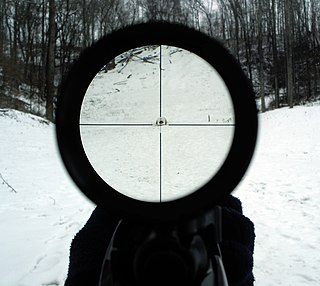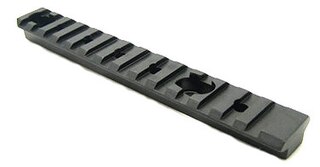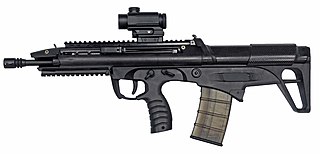In NATO, a standardization agreement defines processes, procedures, terms, and conditions for common military or technical procedures or equipment between the member countries of the alliance. Each NATO state ratifies a STANAG and implements it within its own military. The purpose is to provide common operational and administrative procedures and logistics, so one member nation's military may use the stores and support of another member's military. STANAGs also form the basis for technical interoperability between a wide variety of communication and information systems (CIS) essential for NATO and Allied operations. The Allied Data Publication 34 (ADatP-34) NATO Interoperability Standards and Profiles which is covered by STANAG 5524, maintains a catalogue of relevant information and communication technology standards.

The Heckler & KochXM8 is a lightweight assault rifle system developed from the late 1990s to early 2000s. The rifle was designed by German small arms manufacturer Heckler & Koch (H&K), and shares design and engineering with their G36 rifle.

The Picatinny rail, or Pic rail for short, also known as a MIL-STD-1913 rail, 1913 rail or STANAG 2324 rail (cancelled), is an American design rail integration system that provides a mounting platform for firearm accessories. It was originally used for mounting of scopes atop the receivers of larger caliber rifles.

A telescopic sight, commonly called a scope informally, is an optical sighting device based on a refracting telescope. It is equipped with some form of a referencing pattern – known as a reticle – mounted in a focally appropriate position in its optical system to provide an accurate point of aim. Telescopic sights are used with all types of systems that require magnification in addition to reliable visual aiming, as opposed to non-magnifying iron sights, reflector (reflex) sights, holographic sights or laser sights, and are most commonly found on long-barrel firearms, particularly rifles, usually via a scope mount. Similar devices are also found on other platforms such as Artillery, Tanks and even Aircraft. The optical components may be combined with optoelectronics to add night vision or smart device features.

The Ares Defense Shrike 5.56 is an air-cooled, dual-feed rifle for semi or full-auto configurations that fires the 5.56×45mm NATO cartridge. The Shrike 5.56 can be supplied as a complete weapon, or as an upper receiver “performance upgrade kit” to existing M16-type service rifles and carbines. it is named after the Shrike, a carnivorous passerine bird, and was designed by Geoffrey Herring.

A Weaver rail mount is a system to connect telescopic sights and other accessories to firearms and certain crossbows. It uses a pair of parallel rails and several slots perpendicular to these rails.

A rail integration system is a generic term for a standardized system for attaching accessories to firearms. Rail systems are straight mounting brackets on the gun's receiver, handguard, or fore-end stock to allow sliding or variable-position attachments. An advantage of the multiple rail slots is the moveable positions to adjust for optimal placement of each item for a user's preferences, along with the ability to switch different items at different placements due to varying eye reliefs on gun sights.

The APR is a bolt-action sniper rifle designed by the Thun-based Brügger & Thomet in 2003 as an evolution of the French PGM Précision.
The C14 Timberwolf MRSWS is a bolt-action sniper rifle built by the Canadian arms company PGW Defence Technologies Inc. In 2005 they won the contract to supply the Canadian Forces Land Command with the C14 Timberwolf MRSWS for $4.5 million.
The FN Model 30-11 is a Belgian bolt-action sniper rifle, manufactured between 1976 and 1986.

The IWI Galil ACE is a family of assault rifles and battle rifles originally developed and manufactured by Israel Weapon Industries (IWI). It is produced in three different calibres: 5.56×45mm NATO, 7.62×39mm and 7.62×51mm NATO.

KeyMod is a universal interface system for firearm accessory components designed to supersede the MIL-STD-1913 "Picatinny" accessory rails. The concept was first created by VLTOR Weapon Systems of Tucson, Arizona, and released through Noveske Rifleworks of Grants Pass, Oregon, before being published open sourced in the public domain for adoption by the entire firearms accessory industry. The name "KeyMod" was coined by Eric Kincel following the naming trend of other VLTOR accessories with the suffix "Mod" meaning modular, and "Key" being a reference to the key-hole profile of the mounting slots.

The BR18 is a bullpup assault rifle made by ST Kinetics of Singapore.

M-LOK, for Modular Lock, is a firearm rail interface system developed and patented by Magpul Industries. The license is free-of-charge, but subject to an approval process.

The UIT rail, also known as Anschutz rail, is a standard used for mounting slings and other gun accessories in competition shooting, and is essentially a T-slot track shaped aluminium extrusion profile accepting attachments in the form of T-slot nuts, or similar.
The Ak 4 is a license-built Swedish version of the West German Heckler & Koch G3 battle rifle. It was adopted as the service rifle of the Swedish Armed Forces in 1965, replacing the bolt-action m/96 Mauser.
The Heckler & Koch HK433 is a modular assault rifle chambered for 5.56×45mm which combines features of the G36 and the HK416 families of assault rifles.

A dovetail rail or dovetail mount can refer to several types of sliding rail system found on firearms, primarily for mounting telescopic sights. Colloquially, the term dovetail rail usually refer to any straight mounting bracket with an inverted trapezoid (dovetail) cross-section running parallel to the bore for mounting a scope or diopter sight to a rifle. These are sometimes also called "tip-off" mounts, and allow the user to easily take on or off the sight. Dovetail mount can also refer to a dovetail track running perpendicular to the bore.

The CAR 816, also called Caracal Sultan or simply Sultan, is a 5.56×45mm NATO, gas-operated, magazine-fed assault rifle that is produced by Caracal International in Abu Dhabi, United Arab Emirates. The rifle is also called Sultan in memory of the Emirati Colonel Sultan Mohammed Ali al-Kitbi who was killed in action in Saudi-led intervention in Yemen.

Scope mounts are used to attach telescopic sights or other types of sights to firearms. The scope sight itself is usually made for only one of two main types of mounts, which can be classified as scopes for ring mounts, for example a 30 mm tube, or scopes for rail mounts, such as the Zeiss rail. Words such as mounts and bases are used somewhat loosely, and can refer to several different parts which are either used together or in place of each other as ways to mount optical sights to firearms.

















